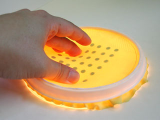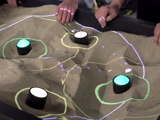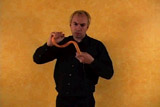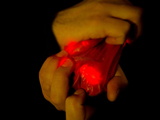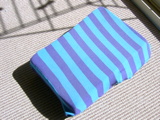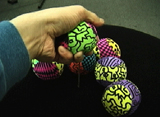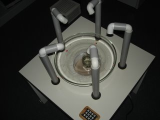Malleable Objects and Surfaces
-
Malleable Surface Interface
year: 2004
author(s): Florian Vogt,
Timothy Chen,
Reynald Hoskinson,
Sidney Fels
affiliation: Human Communication Technologies Laboratory,
University of British Columbia
publication: A Malleable Surface Touch Interface [PDF]
website: http://hct.ece.ubc.ca/research/malleable/
The malleable surface touch interface combines a deformable input surface and video processing to provide a whole-hand interface that exhibits many attributes of conventional touch interfaces, such as multi-point and pressure sensitivity. This interface also offer passive haptic feedback, which can be effective with applications such as sculpting or massage.
-
Sand Noise Device
year: 2014
author(s): Devin Dominquez,
James Saxon,
Jay Van Dyke,
Matt Roads
affiliation: California State University, East Bay
website: http://sandnoisedevice.com/
The Sand Noise Device (SND) is an interactive art installation. It was developed with the goal of creating an intuitive and tactile method for controlling and interacting with a generative electronic music system. This goal was realized in the form of an augmented reality musical sandbox.
Various virtual objects are projected onto the sand. These virtual objects react to the shape of the sand and the location of several lighted tangible objects. Each one of these virtual objects creates sound as it moves around and interacts with other objects. These sounds combine together to form a complex generative musical soundscape. As users move the tangible objects around and play in the sand they are changing the way in which the music around them is being generated.
The virtual objects behave as if they have a physical presence in the sand. They have mass and obey the laws of gravity. They will slow down when climbing uphill, speed up when flowing downhill, get stuck in pits, and collide with the tangible objects. Users can even push the virtual objects around the sand with their hands.
-
pebblebox
year: 2004
author(s): Sile O'Modhrain,
Georg Essl
affiliation: Media Lab Europe,
Palpable Machines Group
publication: Tactile Interfaces for Granular Synthesis [PDF]
website: http://www.sarc.qub.ac.uk/~somodhrain/palpable/projects.html#enactivemi
The PebbleBox is an example of a granular interaction paradigm, in which the manipulation of physical grains of arbitrary material becomes the basis for interacting with granular sound synthesis models. The sounds made by the grains as they are manipulated are analysed, and parameters such as grain rate, grain amplitude and grain density are extracted. These parameters are then used to control the granulation of arbitrary sound samples in real time. In this way, a direct link is made between the haptic sensation of interacting with grains and the control of granular sounds.
-
sonic banana
year: 2000
author(s): Eric Singer
affiliation: League of Electronic Musical Urban Robots
publication: A Novel Bend-Sensor-Based MIDI Controller [PDF]
website: http://www.singerbots.com/bio/
The Sonic Banana is a MIDI controller and alternative musical instrument in the form of a 2 foot long flexible rubber tube. Four bend sensors, each 5" long, are mounted in a row along the inside of the tube on a flexible metal bar running the length of the tube. A single pushbutton switch is mounted at the top end of the tube.
-
Sculpton
year: 2014
author(s): Alberto Boem
affiliation: Interface Cultures, University of Art and Design Linz
publication: Sculpton: A Malleable Tangible Interface for Sound Sculpting [PDF]
website: http://www.albertoboem.com/index.php/project/sculpton/
SculpTon is a malleable interface for musical expression oriented to live performances, which combines a deformable input surface and an embodied sound model of the human voice. SculpTon is based on the idea of sculpting as a way for promoting and creating an active and engaging relation between the performer and the musical artifact. Through this interface a performer can explore sculpt a sonic space that is far from vocality or singing, but is something more closed to the origins of the language and the emergence of utterance. The performer and the interface are then struggling together in a physical-sonic act that is ambiguous, funny but also deeply disturbing. After different stages of refinement, SculpTon is now a stability and playability that makes this interface quite unique, and even strange.
-
The Sponge
year: 2010
author(s): Martin Marier
affiliation: Université de Montréal
publication: The Sponge: A Flexible Interface [PDF]
website: http://www.martinmarier.com/wp/?page_id=12
The sponge is a piece of foam equipped with sensors (accelerometers and force sensing resistors) which can detect when it is squeezed, twisted or shaken. Sensor data is then sent wirelessly (XBee protocol) to a computer. It could probably be used to control any kind of digital process (like video or lighting), but I designed it as a musical interface. I use it in live performances to control sound synthesis and processing.
-
squeezables
year: 2001
author(s): Gil Weinberg,
Seum-Lim Gan
affiliation: MIT Medialab
publication: An Expressive and Interdependent Multi-Player Musical Instrument [PDF]
website: http://xenia.media.mit.edu/~gan/Gan/Education/MIT/MediaLab/Research/Squeezables
The Squeezables is a computer music instrument that allows a group of players to perform and improvise musical compositions by using a set of squeezing and pulling gestures. The instrument, comprised of six squeezable and retractable gel balls mounted on a small podium, addresses a number of hardware and software challenges in electronic music interface design. It is designed to provide an alternative to asynchronous and discursive interactions with discrete musical controllers by allowing multiple channels of high-level simultaneous input. The instrument also addresses new challenge es in interconnected group playing by providing an infrastructure for the development of interdependent, yet coherent, multi-player interactions. As a test case for a particular high level control and interdependent mapping scheme, a short musical composition was written for the instrument and was performed by three players.
-
Toriton Plus
year: 2006
author(s): Sebastian Tomczak
website: http://little-scale.blogspot.com/2006/11/toriton-plus.html
Toriton Plus is using a water surface as a music controller using five lasers. The laser shines through the water in the dish, and LDR's on the other side respond to the position of the laser points. The software used for the configuration has been written using Max/MSP.
